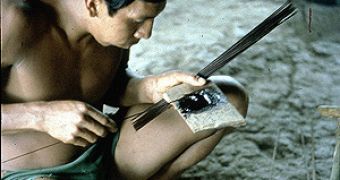There are at least 500 species of medicinal plants utilized by the Indians of Amazon. 10 species coming from the Amazon are already employed by drug companies.
Cat's claw (Uncaria tomentosa) is a woody vine related to the coffee tree, employed locally in Amazonia (Peru, Bolivia and Ecuador), drunk as infusion. The plant attracted the attention of the drug companies due to its antiviral and immune system boosting qualities. Its name comes from the two spines located at the base of the leaf.
Sangre de drago "dragon blood" (Croton lechleri), a tree related with the spurges and rubber tree, whose bark secretes a reddish latex. It has scaring, anti-ulcer, anti-diarrhea properties. The tall, heart-shaped leafed tree is abundant in secondary forests. It grows rapidly and by 7 years old has a trunk with a diameter of 30 cm (1 ft). It induces rapid scaring formation on skin wounds and in small doses treats stomach ulcer. The American Shaman company makes from the latex of sangre de drago the drug Provir, employed against chronic diarrhea induced by AIDS. The tree grows in Ecuador, Peru, Columbia, and Bolivia.
Guayusa (Ilex guayusa), a relative of the mate herb and European holly is used by locals as depurative and stimulant. It is taken in infusion.
Local shamen use some plants in ceremonial or sacred rites (they are of course hallucinogen and can be dangerous to handle): ayahuasca or yage (Banispteriopsis caapi) and various species of floripondio (Brugmansia species) from the potato family, closely related to jimsonweed (Datura) and as poisonous as the last.
Other extremely toxic vines and bushes are the base for the venom employed for smearing arrow tips for hunting and fishing. The bark of curare (Strychnos toxifera) is grated and slowly cooked till a dark deadly tar forms, used for daubing the arrow tips. This poison paralyzes quickly the heart. The curare poison is used for making the surgery anesthetic called tubocurarine. In some regions of the Amazon, the curare poison is made of Curarea tecunarum.
The poison of barbasco (Lonchocarpus urucu, L. nicou), bean related plants, affects only fish and invertebrates, confusing them so that they can be collected by hand. The rubbed plants are tossed to the rivers and in half an hour the fish are affected. In other times, this was practiced also in Europe, using mulleins (Verbascum) and leadwort (Plumbago).
The Machiguenga Indians of the Peruvian Amazonia use chemicals extracted from sedge species (Cyperus), called ivenkiki. The sedges are parasitized by a fungus that destroy the fruits and flowers, producing white excrescences, but not the bulb, which starts producing an alkaloid. This bulb, when chewed, represents a physical and mental stimulant. Various types of sedges are used for hunting monkeys, tapirs or fish. The plants are not poisonous, but the indigenous people believe that arrow tips imbibed with this alkaloid have a better shot. Some sedge chemicals are used for improving sight or if introduced in dogs' food, increase animals' olfaction. The Machiguenga women use over 50 species of sedges during the pregnancy and post-partum. Machiguenga people use up to 270 medicinal plants.
Other famous medicinal plants from the Amazon are maca (Lepidium maca), guarana (Paullinia cupana), saragosa (Aristolochia guentheri), quinine tree (Chinchona species), Amazon cinnamon (Ocotea quixos), ablu (Pouteria caimato), bocote (Cordia alliodora) and others.
Many valuable food plants have by the moment just local use, like lulo or naranjilla (Solanum quitoensis) (a tomato relative), babaco (Vasconcellea ?heilbornii) a papaya relative, acai fruits (Euterpe oleracea, a palm), bacuri (Platonis insignis) and cupuacu or cupuarana (Theobroma grandiflorum), a close relative of the cacao tree (Theobroma cacao).

 14 DAY TRIAL //
14 DAY TRIAL //